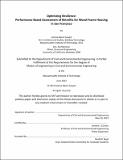| dc.contributor.advisor | Jerome J. Connor. | en_US |
| dc.contributor.author | Saiyed, Zahraa Nazim | en_US |
| dc.contributor.other | Massachusetts Institute of Technology. Department of Civil and Environmental Engineering. | en_US |
| dc.coverage.spatial | n-us-ca | en_US |
| dc.date.accessioned | 2013-12-06T19:51:50Z | |
| dc.date.available | 2013-12-06T19:51:50Z | |
| dc.date.issued | 2013 | en_US |
| dc.identifier.uri | http://hdl.handle.net/1721.1/82719 | |
| dc.description | Thesis (M. Eng.)--Massachusetts Institute of Technology, Department of Civil and Environmental Engineering, 2013. | en_US |
| dc.description | This electronic version was submitted by the student author. The certified thesis is available in the Institute Archives and Special Collections. | en_US |
| dc.description | Cataloged from student-submitted PDF version of thesis. Page [125] blank. | en_US |
| dc.description | Includes bibliographical references (pages 123-124). | en_US |
| dc.description.abstract | Prevalent seismic hazards in the San Francisco Bay Area region require the building stock to be able to withstand frequent ground accelerations while maintaining life-safety standards. Most housing in the City of San Francisco is more than a century old and unable to comply with the increasingly stringent code requirements. Wood-frame multi-unit structures in the City are especially vulnerable to ground movement due to soft-stories located on the first level, which makes structural retrofit a necessary means to safeguard lives and prevent building collapse. This study conducts a performance based seismic assessment to an eight-unit, four-story woodframe structure typical in San Francisco to appraise the building's response to incremental seismic mitigation strategies. The goal of the research is to optimize retrofit based on minimization of lifetime damage costs due to seismic impacts. The investigation seeks to evaluate performance of existing urban housing through the application of a seismic assessment methodology typically used for new construction or high stake buildings. The performance assessment uses a simplified procedure delineated by Ghisbain,1 decreasing the computational intensity of the simulations and affording more retrofit iterations for design optimization. Results show that lifetime damage can be significantly reduced for the considered wood-frame building with applied retrofits, and that minimization of lifetime losses corresponds to augmented retrofit costs. The research concludes with a discussion on prescribing retrofits for a building's longevity versus recommendations for short-term solutions that only call for the structure to fall within code-required life-safety limits. Long-term cost implications can vary greatly, which has necessitated this comprehensive evaluation of the wood-frame structure's behavior and lifetime damages such that it can be conveyed to stakeholders and decision-makers for meaningful planning towards the City's resilience. | en_US |
| dc.description.statementofresponsibility | by Zahraa Nazim Saiyed. | en_US |
| dc.format.extent | 124, [1] pages | en_US |
| dc.language.iso | eng | en_US |
| dc.publisher | Massachusetts Institute of Technology | en_US |
| dc.rights | M.I.T. theses are protected by
copyright. They may be viewed from this source for any purpose, but
reproduction or distribution in any format is prohibited without written
permission. See provided URL for inquiries about permission. | en_US |
| dc.rights.uri | http://dspace.mit.edu/handle/1721.1/7582 | en_US |
| dc.subject | Civil and Environmental Engineering. | en_US |
| dc.title | Optimizing resilience : performance based assessment of retrofits for wood-frame housing in San Francisco | en_US |
| dc.title.alternative | Performance based assessment of retrofits for wood-frame housing in San Francisco | en_US |
| dc.type | Thesis | en_US |
| dc.description.degree | M.Eng. | en_US |
| dc.contributor.department | Massachusetts Institute of Technology. Department of Civil and Environmental Engineering | |
| dc.identifier.oclc | 863152658 | en_US |
